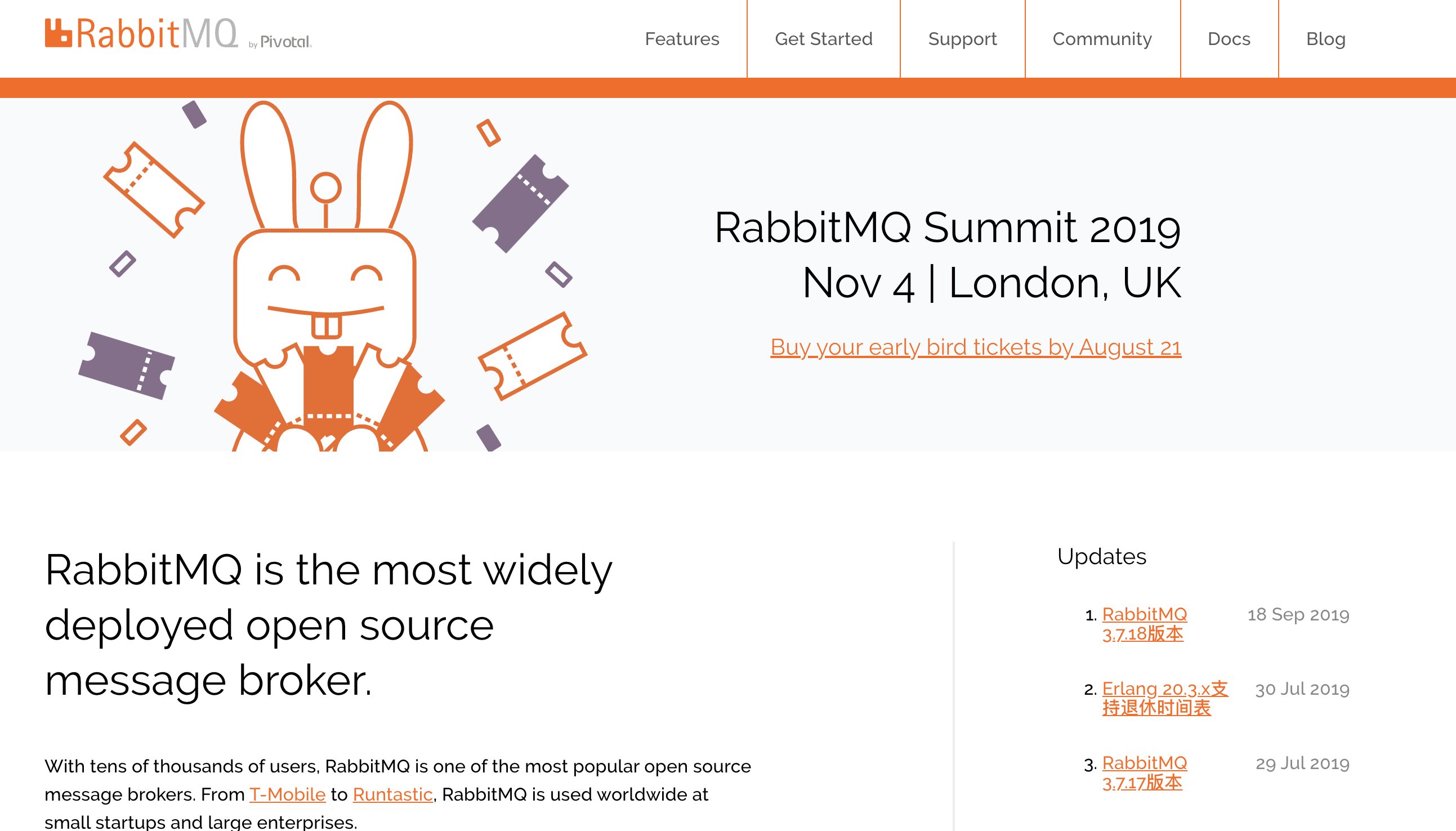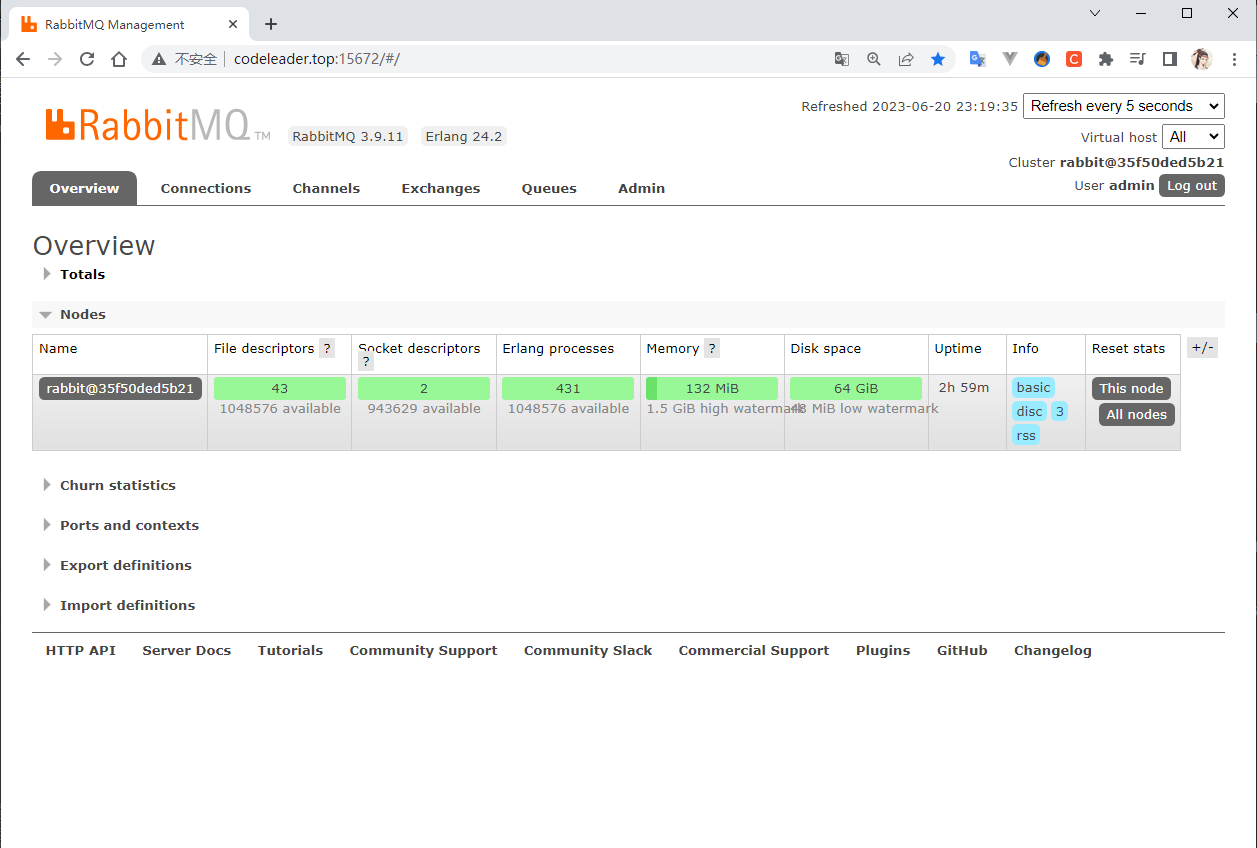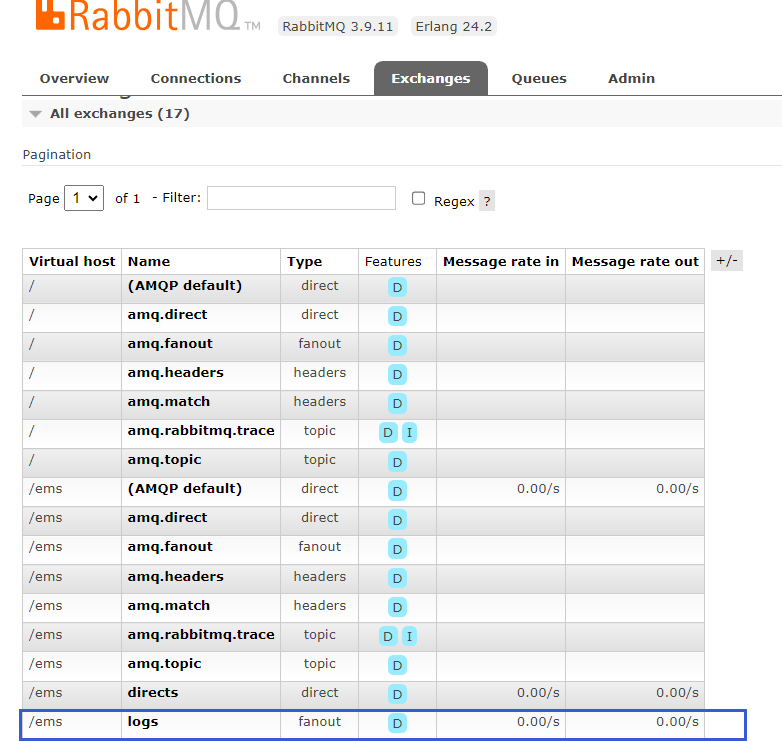RabbitMQ基础
1、MQ引言
1.1 什么是MQ
MQ(Message Quene) : 翻译为消息队列,通过典型的 生产者和消费者模型,生产者不断向消息队列中生产消息,消费者不断的从队列中获取消息。因为消息的生产和消费都是异步的,而且只关心消息的发送和接收,没有业务逻辑的侵入,轻松的实现系统间解耦。别名为 消息中间件通过利用高效可靠的消息传递机制进行平台无关的数据交流,并基于数据通信来进行分布式系统的集成。
1.2 MQ有哪些
当今市面上有很多主流的消息中间件,如老牌的ActiveMQ、RabbitMQ,炙手可热的Kafka,阿里巴巴自主开发RocketMQ等。
1.3 不同MQ特点
# 1.ActiveMQ
ActiveMQ 是Apache出品,最流行的,能力强劲的开源消息总线。它是一个完全支持JMS规范的的消息中间件。丰富的API,多种集群架构模式让ActiveMQ在业界成为老牌的消息中间件,在中小型企业颇受欢迎!
# 2.Kafka
Kafka是LinkedIn开源的分布式发布-订阅消息系统,目前归属于Apache顶级项目。Kafka主要特点是基于Pull的模式来处理消息消费,
追求高吞吐量,一开始的目的就是用于日志收集和传输。0.8版本开始支持复制,不支持事务,对消息的重复、丢失、错误没有严格要求,
适合产生大量数据的互联网服务的数据收集业务。
# 3.RocketMQ
RocketMQ是阿里开源的消息中间件,它是纯Java开发,具有高吞吐量、高可用性、适合大规模分布式系统应用的特点。RocketMQ思路起
源于Kafka,但并不是Kafka的一个Copy,它对消息的可靠传输及事务性做了优化,目前在阿里集团被广泛应用于交易、充值、流计算、消
息推送、日志流式处理、binglog分发等场景。
# 4.RabbitMQ
RabbitMQ是使用Erlang语言开发的开源消息队列系统,基于AMQP协议来实现。AMQP的主要特征是面向消息、队列、路由(包括点对点和
发布/订阅)、可靠性、安全。AMQP协议更多用在企业系统内对数据一致性、稳定性和可靠性要求很高的场景,对性能和吞吐量的要求还在
其次。
RabbitMQ比Kafka可靠,Kafka更适合IO高吞吐的处理,一般应用在大数据日志处理或对实时性(少量延迟),可靠性(少量丢数据)要求稍低的场景使用,比如ELK日志收集。
2、RabbitMQ引言
2.1 RabbitMQ
基于
AMQP协议,erlang语言开发,是部署最广泛的开源消息中间件,是最受欢迎的开源消息中间件之一。

官方教程: https://www.rabbitmq.com/#getstarted
AMQP协议:
AMQP(advanced message queuing protocol)`在2003年时被提出,最早用于解决金融领不同平台之间的消息传递交互问题。顾名思义,AMQP是一种协议,更准确的说是一种binary wire-level protocol(链接协议)。这是其和JMS的本质差别,AMQP不从API层进行限定,而是直接定义网络交换的数据格式。这使得实现了AMQP的provider天然性就是跨平台的。以下是AMQP协议模型:

2.2 RabbitMQ安装
这个以前写过,不重复介绍了 https://codeleader.blog.csdn.net/article/details/121890708
3、RabbitMQ配置
3.1 RabbitMQ命令行
# 1.服务启动相关
systemctl start|restart|stop|status rabbitmq-server
# 2.管理命令行 用来在不使用web管理界面情况下命令操作RabbitMQ
rabbitmqctl help 可以查看更多命令
# 3.插件管理命令行
rabbitmq-plugins enable|list|disable
3.2 Web管理界面
3.2.1 overview概览

connections:无论生产者还是消费者,都需要与RabbitMQ建立连接后才可以完成消息的生产和消费,在这里可以查看连接情况channels:通道,建立连接后,会形成通道,消息的投递获取依赖通道。Exchanges:交换机,用来实现消息的路由Queues:队列,即消息队列,消息存放在队列中,等待消费,消费后被移除队列。
3.2.2 Admin用户和虚拟主机管理
1、添加用户

上面的Tags选项,其实是指定用户的角色,可选的有以下几个:
超级管理员(administrator)可登陆管理控制台,可查看所有的信息,并且可以对用户,策略(policy)进行操作。
监控者(monitoring)可登陆管理控制台,同时可以查看rabbitmq节点的相关信息(进程数,内存使用情况,磁盘使用情况等)
策略制定者(policymaker)可登陆管理控制台, 同时可以对policy进行管理。但无法查看节点的相关信息(上图红框标识的部分)。
普通管理者(management)仅可登陆管理控制台,无法看到节点信息,也无法对策略进行管理。
其他无法登陆管理控制台,通常就是普通的生产者和消费者。
2、创建虚拟主机

默认创建虚拟主机之后,没有用户可以使用,需要绑定用户
3、绑定虚拟主机和用户
创建好虚拟主机,我们还要给用户添加访问权限:
点击添加好的虚拟主机:

这里给admin和ems都授权,授权之后就能在页面上看到了,如下图
4、RabbitMQ常用消息模型测试
4.1 RabbitMQ支持的消息模型


4.2 引入依赖
<!-- https://mvnrepository.com/artifact/com.rabbitmq/amqp-client -->
<dependency>
<groupId>com.rabbitmq</groupId>
<artifactId>amqp-client</artifactId>
<version>5.16.0</version>
</dependency>
4.3 第一种模型:直连

在上图的模型中,有以下概念:
- P:生产者,也就是要发送消息的程序
- C:消费者:消息的接受者,会一直等待消息到来。
- queue:消息队列,图中红色部分。类似一个邮箱,可以缓存消息;生产者向其中投递消息,消费者从其中取出消息。
4.3.1 自定义连接工具类
ublic class RabbitUtils {
//创建连接MQ的连接工厂 重量级资源
public static ConnectionFactory connectionFactory=new ConnectionFactory();
static { //类加载执行 只执行一次
//设置连接rabbitmq主机
connectionFactory.setHost("ip");
//设置端口号
connectionFactory.setPort(5672);
//设置连接哪个虚拟主机
connectionFactory.setVirtualHost("/ems");
//设置访问虚拟主机的用户名和密码
connectionFactory.setUsername("ems");
connectionFactory.setPassword("密码");
}
//定义提供连接对象的方法
public static Connection getConnection() {
Connection connection = null;
try {
//获取连接对象
connection = connectionFactory.newConnection();
} catch (IOException | TimeoutException e) {
e.printStackTrace();
}
return connection;
}
//关闭通道和关闭连接的方法
public static void closeConnectionAndChannel(Channel channel, Connection connection) {
try {
if (channel != null) {
channel.close();
}
if (connection != null) {
connection.close();
}
} catch (IOException | TimeoutException e) {
e.printStackTrace();
}
}
}
4.3.2 生产者
public class Provider {
//生产消息 HelloWorld:直连模式
public static void main(String[] args) throws IOException {
Connection connection= RabbitUtils.getConnection();
//获取连接中的通道
Channel channel = connection.createChannel();
//通道绑定对应的消息队列
//参数1:队列名称,如果不存在,自动创建。
//参数2:定义队列特性是否持久化 true :持久化,false:不持久化
//参数3:是否独占队列
//参数4:是否在消费完成后自动删除队列 true:自动删除,false:不自动删除
//参数5:额外附加参数
channel.queueDeclare("hello",false,false,false,null);
//发布消息
//交换机名称,队列名称,传递消息的额外设置,消息的具体内容
channel.basicPublish("","hello",null,"hello rabbitmq".getBytes());
RabbitUtils.closeConnectionAndChannel(channel,connection);
}
}
这里不指定交换机名称,用的就是默认交换机。
4.3.3 消费者
public class Consumer {
public static void main(String[] args) throws IOException, TimeoutException {
//调用自定义工具类
Connection connection= RabbitUtils.getConnection();
//创建通道
Channel channel = connection.createChannel();
//通道绑定对象
channel.queueDeclare("hello",true,false,true,null);
//消费消息
//参数1:消费哪个队列的消息
//参数2:开启消息的自动确认机制
//参数3:消费消息时的回调接口
channel.basicConsume("hello",true,new DefaultConsumer(channel){
//body:消息队列中取出的消息
@Override
public void handleDelivery(String consumerTag, Envelope envelope, AMQP.BasicProperties properties, byte[] body) throws IOException {
System.out.println("=============="+new String(body));
}
});
//调用工具类
RabbitUtils.closeConnectionAndChannel(channel,connection);
}
}
启动生产者:

启动消费者:

可以看到,消息已经收到了
4.4 第二种模型:Work Queue
Work queues,也被称为(Task queues`),任务模型。当消息处理比较耗时的时候,可能生产消息的速度会远远大于消息的消费速度。长此以往,消息就会堆积越来越多,无法及时处理。此时就可以使用work 模型:让多个消费者绑定到一个队列,共同消费队列中的消息。队列中的消息一旦消费,就会消失,因此任务是不会被重复执行的。

角色:
- P:生产者:任务的发布者
- C1:消费者-1,领取任务并且完成任务,假设完成速度较慢
- C2:消费者-2:领取任务并完成任务,假设完成速度快
4.4.1 生产者:
public class Provider {
public static void main(String[] args) throws IOException {
//获取连接对象
Connection connection = RabbitUtils.getConnection();
Channel channel = connection.createChannel();
//通过通道声明队列
channel.queueDeclare("work",true,false,false,null);
//生产消息
for (int i = 1; i <=20 ; i++) {
channel.basicPublish("","work", null,(i+" hello work queue").getBytes());
}
//关闭资源
RabbitUtils.closeConnectionAndChannel(channel,connection);
}
}
4.4.2 消费者
消费者1:
//轮询分发测试
public class Consumer1 {
public static void main(String[] args) throws IOException {
Connection connection = RabbitUtils.getConnection();
Channel channel = connection.createChannel();
channel.queueDeclare("work",true,false,false,null);
channel.basicConsume("work",true,new DefaultConsumer(channel){
@Override
public void handleDelivery(String consumerTag, Envelope envelope, AMQP.BasicProperties properties, byte[] body) throws IOException {
System.out.println("消费者-1:"+new String(body));
try {
Thread.sleep(1000);
} catch (InterruptedException e) {
e.printStackTrace();
}
}
});
}
}
消费者2:
public class Consumer2 {
public static void main(String[] args) throws IOException {
Connection connection = RabbitUtils.getConnection();
Channel channel = connection.createChannel();
channel.queueDeclare("work",true,false,false,null);
//参数1:队列名称,参数2:消息自动确认 true:消费者自动向rabbitmq确认消息消费了,false:不会自动确认消息
channel.basicConsume("work",true,new DefaultConsumer(channel){
@Override
public void handleDelivery(String consumerTag, Envelope envelope, AMQP.BasicProperties properties, byte[] body) throws IOException {
System.out.println("消费者-2:"+new String(body));
}
});
}
}
先启动两个消费者

再启动生产者:


总结:默认情况下,RabbitMQ将按顺序将每个消息发送给下一个使用者。平均而言,每个消费者都会收到相同数量的消息。这种分发消息的方式称为循环。可以看到,默认是轮询分发的,但是这样子不好,我们的消费者1使用线程休眠了1s处理的很慢依然和消费者2五五开。
我们想要的结果是能者多劳,也就是处理速度快的就尽量多处理几条消息。
改进如下:
- 设置一次只接受一条未确认的消息
- 关闭消息自动确认,改为手动确认
4.4.3 改进为能者多劳
生产者不动,改变消费者
消费者1:
//能者多劳测试
public class Consumer1 {
public static void main(String[] args) throws IOException {
Connection connection = RabbitUtils.getConnection();
Channel channel = connection.createChannel();
channel.basicQos(1);//每次只能消费一个消息
channel.queueDeclare("work",true,false,false,null);
channel.basicConsume("work",false,new DefaultConsumer(channel){
@Override
public void handleDelivery(String consumerTag, Envelope envelope, AMQP.BasicProperties properties, byte[] body) throws IOException {
System.out.println("消费者-1:"+new String(body));
//手动确认
//参数1:手动确认消息标识, 参数2:false 每次确认一个
channel.basicAck(envelope.getDeliveryTag(),false);
try {
Thread.sleep(1000);
} catch (InterruptedException e) {
e.printStackTrace();
}
}
});
}
}
消费者2:
public class Consumer2 {
public static void main(String[] args) throws IOException {
Connection connection = RabbitUtils.getConnection();
Channel channel = connection.createChannel();
channel.basicQos(1);//每次只能消费一个消息
channel.queueDeclare("work",true,false,false,null);
//参数1:队列名称,参数2:消息自动确认 true:消费者自动向rabbitmq确认消息消费了,false:不会自动确认消息
channel.basicConsume("work",false,new DefaultConsumer(channel){
@Override
public void handleDelivery(String consumerTag, Envelope envelope, AMQP.BasicProperties properties, byte[] body) throws IOException {
System.out.println("消费者-2:"+new String(body));
//手动确认
//参数1:手动确认消息标识, 参数2:false 每次确认一个
channel.basicAck(envelope.getDeliveryTag(),false);
}
});
}
}
消费者2:

消费者2:

可以看到,达到了能者多劳的效果
4.5 第三种模型:Fanout
fanout 扇出 也称为广播


在广播模式下,消息发送流程是这样的:
- 可以有多个消费者
- 每个消费者有自己的queue(队列)
- 每个队列都要绑定到Exchange(交换机)
- 生产者发送的消息,只能发送到交换机,交换机来决定要发给哪个队列,生产者无法决定。
- 交换机把消息发送给绑定过的所有队列
- 队列的消费者都能拿到消息。实现一条消息被多个消费者消费
4.5.1 生产者
public class Provider {
public static void main(String[] args) throws IOException {
Connection connection = RabbitUtils.getConnection();
Channel channel = connection.createChannel();
//将通道声明指定的交换机
//参数1:交换机名称,参数2:交换机类型,fanout:广播类型
channel.exchangeDeclare("logs","fanout");
//发送消息 fanout中的routingkey没啥作用
channel.basicPublish("logs","",null,"fanout type message".getBytes());
RabbitUtils.closeConnectionAndChannel(channel,connection);
}
4.5.2 开发3个消费者
消费者1:
public class Consumer1 {
public static void main(String[] args) throws IOException {
Connection connection = RabbitUtils.getConnection();
Channel channel = connection.createChannel();
//声明交换机
channel.exchangeDeclare("logs","fanout");
//临时队列
String queueName = channel.queueDeclare().getQueue();
//绑定交换机和队列
channel.queueBind(queueName,"logs","");
//消费消息
channel.basicConsume(queueName,true,new DefaultConsumer(channel){
@Override
public void handleDelivery(String consumerTag, Envelope envelope, AMQP.BasicProperties properties, byte[] body) throws IOException {
System.out.println("消费者1:"+new String(body));
}
});
}
}
消费者2:
public class Consumer2 {
public static void main(String[] args) throws IOException {
Connection connection = RabbitUtils.getConnection();
Channel channel = connection.createChannel();
//声明交换机
channel.exchangeDeclare("logs","fanout");
//临时队列
String queueName = channel.queueDeclare().getQueue();
//绑定交换机和队列
channel.queueBind(queueName,"logs","");
//消费消息
channel.basicConsume(queueName,true,new DefaultConsumer(channel){
@Override
public void handleDelivery(String consumerTag, Envelope envelope, AMQP.BasicProperties properties, byte[] body) throws IOException {
System.out.println("消费者2:"+new String(body));
}
});
}
}
public class Consumer3 {
public static void main(String[] args) throws IOException {
Connection connection = RabbitUtils.getConnection();
Channel channel = connection.createChannel();
//声明交换机
channel.exchangeDeclare("logs","fanout");
//临时队列
String queueName = channel.queueDeclare().getQueue();
//绑定交换机和队列
channel.queueBind(queueName,"logs","");
//消费消息
channel.basicConsume(queueName,true,new DefaultConsumer(channel){
@Override
public void handleDelivery(String consumerTag, Envelope envelope, AMQP.BasicProperties properties, byte[] body) throws IOException {
System.out.println("消费者3:"+new String(body));
}
});
}
}
先启动3个消费者
启动生产者之后观察3个消费者是否都接收到了消息:



观察是否创建了对应的交换机:

4.6 第四种模型:Routing
其实Routing和Topics很像,一个是写死了RoutingKey,另一个使用了通配符。
在Fanout模式中,一条消息,会被所有订阅的队列都消费。但是,在某些场景下,我们希望不同的消息被不同的队列消费。这时就要用到Direct类型的Exchange。
在Direct模型下:
- 队列与交换机的绑定,不能是任意绑定了,而是要指定一个
RoutingKey(路由key) - 消息的发送方在 向 Exchange发送消息时,也必须指定消息的
RoutingKey。 - Exchange不再把消息交给每一个绑定的队列,而是根据消息的
Routing Key进行判断,只有队列的Routingkey与消息的Routing key完全一致,才会接收到消息

图解:
- P:生产者,向Exchange发送消息,发送消息时,会指定一个routing key。
- X:Exchange(交换机),接收生产者的消息,然后把消息递交给 与routing key完全匹配的队列
- C1:消费者,其所在队列指定了需要routing key 为 error 的消息
- C2:消费者,其所在队列指定了需要routing key 为 info、error、warning 的消息
4.6.1 生产者
public class Provider {
public static final String EXCHANGE_NAME="logs_direct";
public static void main(String[] args) throws IOException {
Connection connection = RabbitUtils.getConnection();
Channel channel = connection.createChannel();
//声明交换机 参数1:交换机名称,参数2:direct 路由模式
channel.exchangeDeclare(EXCHANGE_NAME, BuiltinExchangeType.DIRECT);
//发送消息
// String routingKey="info";
// String routingKey="error";
String routingKey="warning";
// String routingKey="trade";
channel.basicPublish(EXCHANGE_NAME,routingKey,null,("这是direct模型发布的基于routingKey:["+routingKey+"]").getBytes());
//关闭资源
RabbitUtils.closeConnectionAndChannel(channel,connection);
}
}
4.6.2 消费者1
public class Consumer1 {
public static final String EXCHANGE_NAME="logs_direct";
public static void main(String[] args) throws IOException {
Connection connection = RabbitUtils.getConnection();
Channel channel = connection.createChannel();
//通道声明交换机以及交换机的类型
channel.exchangeDeclare(EXCHANGE_NAME, BuiltinExchangeType.DIRECT);
//创建一个临时队列
String queue = channel.queueDeclare().getQueue();
//基于routingKey去绑定队列和交换机
channel.queueBind(queue,EXCHANGE_NAME,"error");
//消费消息
channel.basicConsume(queue,true,new DefaultConsumer(channel){
@Override
public void handleDelivery(String consumerTag, Envelope envelope, AMQP.BasicProperties properties, byte[] body) throws IOException {
System.out.println("消费者1:"+new String(body));
}
});
}
}
4.6.3 消费者2
public class Consumer2 {
public static final String EXCHANGE_NAME="logs_direct";
public static void main(String[] args) throws IOException {
Connection connection = RabbitUtils.getConnection();
Channel channel = connection.createChannel();
//通道声明交换机以及交换机的类型
channel.exchangeDeclare(EXCHANGE_NAME, BuiltinExchangeType.DIRECT);
//创建一个临时队列
String queue = channel.queueDeclare().getQueue();
//基于routingKey去绑定队列和交换机
channel.queueBind(queue,EXCHANGE_NAME,"info");
channel.queueBind(queue,EXCHANGE_NAME,"error");
channel.queueBind(queue,EXCHANGE_NAME,"warning");
//消费消息
channel.basicConsume(queue,true,new DefaultConsumer(channel){
@Override
public void handleDelivery(String consumerTag, Envelope envelope, AMQP.BasicProperties properties, byte[] body) throws IOException {
System.out.println("消费者2:"+new String(body));
}
});
}
}
先启动两个消费者:

启动生产者之后观察消费者是否收到了消息:


可以看到,消费者1没有收到消息,因为我们生产者的routintKey为warning,而消费者1队列的routingKey是error,消费者2队列的routingKey是warning
所以只有消费者2可以接收到消息,只有队列的Routingkey与消息的 Routing key完全一致,才会接收到消息。
4.7 第五种模型:Topics
Topic类型的Exchange与Direct相比,都是可以根据RoutingKey把消息路由到不同的队列。只不过Topic类型Exchange可以让队列在绑定Routing key 的时候使用通配符!这种模型Routingkey 一般都是由一个或多个单词组成,多个单词之间以”.”分割,例如: item.insert

# 统配符
* (star) can substitute for exactly one word. 匹配不多不少恰好1个词
# (hash) can substitute for zero or more words. 匹配一个或多个词
# 如:
audit.# 匹配audit.irs.corporate或者 audit.irs 等
audit.* 只能匹配 audit.irs
4.7.1 生产者
public class Provider {
public static void main(String[] args) throws IOException {
Connection connection = RabbitUtils.getConnection();
Channel channel = connection.createChannel();
//声明交换机以及交换机类型 topic
channel.exchangeDeclare("topics", BuiltinExchangeType.TOPIC);
//发布消息
String routingKey="user.save";
// String routingKey="user.save.findAll";
// String routingKey="user";
channel.basicPublish("topics",routingKey,null,("这里是topic动态路由模型,routingKey:["+routingKey+"]").getBytes());
//关闭资源
RabbitUtils.closeConnectionAndChannel(channel,connection);
}
}
4.7.2 消费者1:
public class Cosumer1 {
public static void main(String[] args) throws IOException {
Connection connection = RabbitUtils.getConnection();
Channel channel = connection.createChannel();
//声明交换机以及交换机类型
channel.exchangeDeclare("topics", BuiltinExchangeType.TOPIC);
//创建临时队列
String queue = channel.queueDeclare().getQueue();
//创建队列和交换机,动态通配符形式 routingKey
channel.queueBind(queue,"topics","user.*");
//消费消息
channel.basicConsume(queue,true,new DefaultConsumer(channel){
@Override
public void handleDelivery(String consumerTag, Envelope envelope, AMQP.BasicProperties properties, byte[] body) throws IOException {
System.out.println("消费者1:"+new String(body));
}
});
}
}
4.7.3 消费者2:
public class Cosumer2 {
public static void main(String[] args) throws IOException {
Connection connection = RabbitUtils.getConnection();
Channel channel = connection.createChannel();
//声明交换机以及交换机类型
channel.exchangeDeclare("topics", BuiltinExchangeType.TOPIC);
//创建临时队列
String queue = channel.queueDeclare().getQueue();
//创建队列和交换机,动态通配符形式 routingKey
channel.queueBind(queue,"topics","user.#");
//消费消息
channel.basicConsume(queue,true,new DefaultConsumer(channel){
@Override
public void handleDelivery(String consumerTag, Envelope envelope, AMQP.BasicProperties properties, byte[] body) throws IOException {
System.out.println("消费者2:"+new String(body));
}
});
}
}
我们注意到消费者1的routingKey为user.*,消费者2的routingKey为user.#
启动两个消费者,再启动生产者


此时都收到了消息,是因为两个规则都能匹配到。
我们现在将生产者交换机的routingKey改为user.save.findAll,启动生产者,观察结果:


是因为消费者2中队列的routingKey为user.#,user后面可以匹配一个或者多个,而消费者1中队列的routingKey为user.*,user后面只能匹配一个词,所以收不到消息。
就先介绍到这里,后面的RPC暂时不搞了,至于Publisher Confirms看我专栏以前的文章,这几种模式足够应付绝大多数的业务场景了。
5、RabbitMQ与SpringBoot整合
真正写代码的时候都是与现有框架进行集成,很少用上面那种原生的写法。
5.0 搭建环境
5.0.1 引入依赖
<dependency>
<groupId>org.springframework.boot</groupId>
<artifactId>spring-boot-starter-amqp</artifactId>
</dependency>
5.0.2 配置文件
spring:
application:
name: rabbitmq-springboot
rabbitmq:
host: 你的ip
port: 5672
username: 用户名
password: 密码
virtual-host: /ems # 虚拟主机
5.1 第一种:HelloWorld模型
生产者:
//注入rabbitTemplate
@Autowired
private RabbitTemplate rabbitTemplate;
//hello world
@Test
public void testHelloWorld(){
rabbitTemplate.convertAndSend("hello","hello world");
}
消费者:
@Component
@RabbitListener(queuesToDeclare = @Queue(value = "hello"))
public class HelloCustomer {
@RabbitHandler
public void receive(String message){
System.out.println("message="+message);
}
}
由于
@RabbitListener注解会一直监听消息,所以这里不用像上面一样分别启动消费者和生产者了。
我们直接启动生产者:


管理界面却是存在hello队列,控制台也看到消息已经被消费者接收。
5.2 第二种:Work Queue
生产者:
//work queues
@Test
public void testWorkQueue(){
for (int i = 0; i < 10; i++) {
rabbitTemplate.convertAndSend("work","work模型"+i);
}
}
消费者:
@Component
public class WorkCustomer {
//消费者1
@RabbitListener(queuesToDeclare = @Queue("work"))
public void receive(String message){
System.out.println("message1="+message);
}
//消费者2
@RabbitListener(queuesToDeclare = @Queue("work"))
public void receive1(String message){
System.out.println("message2="+message);
}
}
这里我建立两个消费者来测试轮询分发模式


管理界面中看到了绑定的work队列,控制台也看到了消息已经被两个消费者接收。
5.3 第三种:Fanout
生产者:
//fanout 广播
@Test
public void testFanout(){
//这种模式的routingKey没啥作用
rabbitTemplate.convertAndSend("logs","","Fanout的模型发送的消息");
}
定义一个交换机:logs
消费者:
@Component
public class FanoutCustomer {
@RabbitListener(bindings = {
@QueueBinding(
value = @Queue,//不写value代表临时队列
exchange =@Exchange(value = "logs",type ="fanout") //绑定的叫喊及
)
})
public void receive1(String message){
System.out.println("message1= "+message);
}
@RabbitListener(bindings = {
@QueueBinding(
value = @Queue,//不写value代表临时队列
exchange =@Exchange(value = "logs",type ="fanout") //绑定的交换机
)
})
public void receive2(String message){
System.out.println("message2= "+message);
}
}
这里两个临时队列都与logs交换机进行绑定,所以我们生产者将消息发送到logs交换机上面之后,两个消费者都能接收到消息。


5.4 第四种:Routing
生产者:
//routing 路由模式
@Test
public void testRoute(){
// rabbitTemplate.convertAndSend("directs","info","发送info的key的路由信息");
rabbitTemplate.convertAndSend("directs","error","发送info的key的路由信息");
}
消费者:
@Component
public class RouteCustomer {
@RabbitListener(bindings = {
@QueueBinding(
value = @Queue, //创建临时队列
exchange = @Exchange(value = "directs",type = "direct"),//指定交换机
key = {"info","error","warn"}
)
})
public void receive1(String message){
System.out.println("message1= "+message);
}
@RabbitListener(bindings = {
@QueueBinding(
value = @Queue, //创建临时队列
exchange = @Exchange(value = "directs",type = "direct"),//指定交换机
key = {"error"}
)
})
public void receive2(String message){
System.out.println("message2= "+message);
}
}
当routingKey=error的时候,两个消费者都可以接收到:

我们现在将routingKey改为info,再次发送:
rabbitTemplate.convertAndSend("directs","info","发送info的key的路由信息");

可以看到,只有消费者1接收到了消息,因为只有消费者1的队列和交换机进行绑定的
routingKey是"info","error","warn",包含了info,而消费者2中队列和交换机绑定的routingKey为error,所以消费者2接收不到这条消息。
5.4 第五种:Topics
也叫动态路由模型,就是在第四种模型的基础之上加了通配符而已。
生产者:
//topic 动态路由 订阅模式
@Test
public void testTopic(){
rabbitTemplate.convertAndSend("topics","user.save","user.save 路由消息");
// rabbitTemplate.convertAndSend("topics","order","user.save 路由消息");
// rabbitTemplate.convertAndSend("topics","product.save.add","product.save.add 路由消息");
}
消费者:
@Component
public class TopicCustomer {
@RabbitListener(bindings = {
@QueueBinding(
value = @Queue,
exchange = @Exchange(value = "topics",type = "topic"),
key = {"user.save","user.*"}
)
})
public void reveive1(String message){
System.out.println("message1 = "+message);
}
@RabbitListener(bindings = {
@QueueBinding(
value = @Queue,
exchange = @Exchange(value = "topics",type = "topic"),
key = {"order.#","product.#","user.*"}
)
})
public void reveive2(String message){
System.out.println("message2 = "+message);
}
}
此时,生产者中的定义的routingKey为user.save,而消费者1有user.save和user.*,消费者2有:user.*,所以两个都能接收到消息:


控制台看到两个消费者都输出了消息,管理界面中 也看到了新建的交换机。
现在修改生产者消息的routingKey如下:
rabbitTemplate.convertAndSend("topics","order","user.save 路由消息");

可以看到,只有消费者2接收到了消息,这是因为消费者中的routingKey包含"order.#",#代表有一个或者多个单词,所以匹配到。
将生产者代码修改如下:
rabbitTemplate.convertAndSend("topics","product.save.add","product.save.add 路由消息");

消费者2中有
routingKey为product.#,所以能够接收到。
- 点赞
- 收藏
- 关注作者




评论(0)